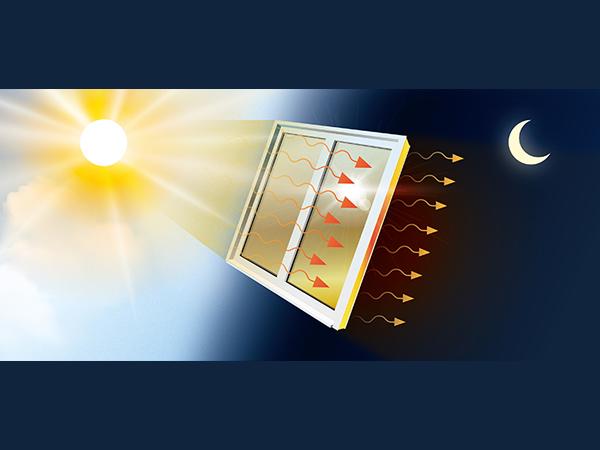
Date: 15 July 2019
The molecule has the unique ability to capture energy from the sun’s rays and release it later as heat. This is shown by researchers at Chalmers University of Technology, Sweden, in the scientific journal Advanced Science.
On sunny summer days, it can be little short of unbearable to stay indoors or in cars. The heat radiates in and creates an unpleasantly high temperature for people, animals, and plants. Using energy-intensive systems such as air conditioning and fans means combating the thermal energy with other forms of energy. Researchers at Chalmers University of Technology are proposing a method that utilises the heat and distributes it evenly over a longer period instead.
When their specially designed molecule is struck by the sun’s rays it captures photons and simultaneously changes form – it is isomerised. When the sun stops shining on the window film the molecules release heat for up to eight hours after the sun has set.
“The aim is to create a pleasant indoor environment even when the sun is at its hottest, without consuming any energy or having to shut ourselves behind blinds. Why not make the most of the energy that we get free of charge instead of trying to fight it,” says chemist Kasper Moth-Poulsen, who is leading the research.
At dawn when the film has not absorbed any solar energy it is yellow or orange since these colours are the opposite of blue and green, which is the light spectrum that the researchers have chosen to capture from the sun. When the molecule captures solar energy and is isomerised, it loses its colour and then becomes entirely transparent.
As long as the sun is shining on the film it captures energy, which means that not as much heat penetrates through the film and into the room. At dusk, when there is less sunlight, heat starts to be released from the film and it gradually returns to its yellow shade and is ready to capture sunlight again the following day.
“For example, airports and office complexes should be able to reduce their energy consumption while also creating a more pleasant climate with our film, since the current heating and cooling systems often do not keep up with rapid temperature fluctuations,” says Moth-Poulsen.
The molecule is part of a concept the research team calls MOST, which stands for ‘Molecular Solar Thermal Storage’. Previously the team presented an energy system for houses based on the same molecule (see the related press release below). In that case – after the solar energy had been captured by the molecule – it could be stored for an extended period, such as from summer to winter, and then used to heat an entire house.
The researchers realised that they could shorten the step to application by optimising the molecule for a window film as well, which would also create better conditions for the slightly more complex energy system for houses.
What the researchers still have to do is to increase the concentration of the molecule in the film whilst also retaining the film’s properties, and bring down the price of the molecule. But according to Moth-Poulsen they are very close to this innovation.
“The step to applying our film is so short that it could happen very soon. We are at a very exciting stage with MOST,” he says.
Timelapse video showing what the technology could look like. Video: Mats Tiborn, Johan Bodell / Chalmers
More about the research
The research has been funded by the Australian Research Council, the Knut and Alice Wallenberg Foundation and the Swedish Strategic Research Foundation.
For more information, contact:
Kasper Moth-Poulsen, Professor of Nanochemistry, Chalmers University of Technology, Sweden, +46 761 99 68 55, kasper.moth-poulsen@chalmers.se
 600450
600450












Add new comment